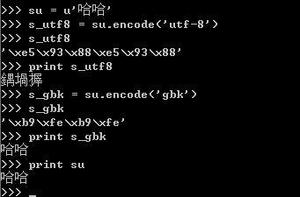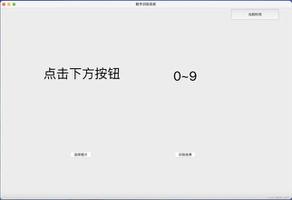python中文乱码问题大总结
![python中文乱码问题大总结[python基础教程]](/wp-content/uploads/new2022/20220602jjjkkk2/5597213839_1.jpg)
在运行这样类似的代码:
#!/usr/bin/env pythons="中文"
print s
最近经常遇到这样的问题:
问题一:SyntaxError: Non-ASCII character 'xe4' in file E:codingpythonUntitled 6.py on line 3, but no encoding declared; see http://www.python.org/peps/pep-0263.html for details
问题二:UnicodeDecodeError: 'ascii' codec can't decode byte 0xe5 in position 108: ordinal not in range(128)
问题三:UnicodeEncodeError: 'gb2312' codec can't encode character u'u2014' in position 72366: illegal multibyte sequence
这些都是跟字符编码有关的问题,很郁闷,中文总是弄不出来,找了很多方案,这里有些是我前几天找到的一些方案,拿出来给大家分享一下哈
字符串在Python内部的表示是unicode 编码,因此,在做编码转换时,通常需要以unicode作为中间编码,即先将其他编码的字符串解码(decode)成unicode,再从unicode编码(encode)成另一种编码。
decode的作用是将其他编码的字符串转换成unicode编码,如str1.decode('gb2312'),表示将gb2312编码的字符串str1转换成unicode编码。
encode的作用是将unicode编码转换成其他编码的字符串,如str2.encode('gb2312'),表示将unicode编码的字符串str2转换成gb2312编码。
在某些IDE中,字符串的输出总是出现乱码,甚至错误,其实是由于IDE的结果输出控制台自身不能显示字符串的编码,而不是程序本身的问题。
如在UliPad中运行如下代码:
s=u"中文"
print s
会提示:UnicodeEncodeError: 'ascii' codec can't encode characters in position 0-1: ordinal not in range(128)。这是因为UliPad在英文WindowsXP 上的控制台信息输出窗口是按照ascii编码输出的(英文系统的默认编码是ascii),而上面代码中的字符串是Unicode编码的,所以输出时产生了错误。
将最后一句改为:print s.encode('gb2312')
则能正确输出“中文”两个字。
若最后一句改为:print s.encode('utf8')
则输出:xe4xb8xadxe6x96x87,这是控制台信息输出窗口按照ascii编码输出utf8编码的字符串的结果。
下面代码可能比较通用一些,如下:
#!/usr/bin/env python#coding=utf-8
s="中文"
if isinstance(s, unicode):
#s=u"中文"
print s.encode("gb2312")
else:
#s="中文"
print s.decode("utf-8").encode("gb2312")
#!/usr/bin/env python
#coding=utf-8
s="中文"
if isinstance(s, unicode):
#s=u"中文"
print s.encode("gb2312")
else:
#s="中文"
print s.decode("utf-8").encode("gb2312")
看看下面一段代码:
#!/usr/bin/env python#coding=utf-8
#python version:2.7.4
#system:windows xp
import httplib2
def getPageContent(url):
"""""
使用httplib2用编程的方式根据url获取网页内容
将bytes形式的内容转换成utf-8的字符串
"""
#使用ie9的user-agent,如果不设置user-agent将会得到403禁止访问
headers={"user-agent":"Mozilla/5.0 (compatible; MSIE 9.0; Windows NT 6.1; Trident/5.0)",
"cache-control":"no-cache"}
if url:
response,content = httplib2.Http().request(url,headers=headers)
if response.status == 200 :
return content
import sysreload(sys)
sys.setdefaultencoding("utf-8") #修改默认编码方式,默认为ascci
print sys.getdefaultencoding()
content = getPageContent("http://www.oschina.net/")
print content.decode("utf-8").encode("gb2312")
#!/usr/bin/env python
#coding=utf-8
#python version:2.7.4
#system:windows xp
import httplib2
def getPageContent(url):
"""
使用httplib2用编程的方式根据url获取网页内容
将bytes形式的内容转换成utf-8的字符串
"""
#使用ie9的user-agent,如果不设置user-agent将会得到403禁止访问
headers={"user-agent":"Mozilla/5.0 (compatible; MSIE 9.0; Windows NT 6.1; Trident/5.0)",
"cache-control":"no-cache"}
if url:
response,content = httplib2.Http().request(url,headers=headers)
if response.status == 200 :
return content
import sysreload(sys)
sys.setdefaultencoding("utf-8") #修改默认编码方式,默认为ascci
print sys.getdefaultencoding()
content = getPageContent("http://www.oschina.net/")
print content.decode("utf-8").encode("gb2312")
上面的代码的意思:向www.oschina.net网站请求他的主页,(如果直接是utf-8编码,不能输出中文)想将编码方式为utf-8转向gd2312,出现问题三
当我把它将print content.decode('utf-8').encode('gb2312')改成 print content.decode('utf-8').encode('gb2312', ‘ignore’)时,OK了,可以显示中文了,但不敢确定是否为全部,貌似只有部分吧,有些不能用gb2312编码
然而,当我把网站换成 www.soso.com时,不用转为gb2312,用utf-8即可正常显示中文
总结一下:
向文件直接输出ss会抛出同样的异常。在处理unicode中文字符串的时候,必须首先对它调用encode函数,转换成其它编码输出。这一点对各个环境都一样。在Python中,“str”对象就是一个字节数组,至于里面的内容是不是一个合法的字符串,以及这个字符串采用什么编码(gbk, utf-8, unicode)都不重要。这些内容需要用户自己记录和判断。这些的限制也同样适用于“unicode”对象。要记住“unicode”对象中的内容可绝对不一定就是合法的unicode字符串,我们很快就会看到这种情况。在windows的控制台上,支持gbk编码的str对象和unicode编码的unicode对象。
以上是 python中文乱码问题大总结 的全部内容, 来源链接: utcz.com/z/537412.html







